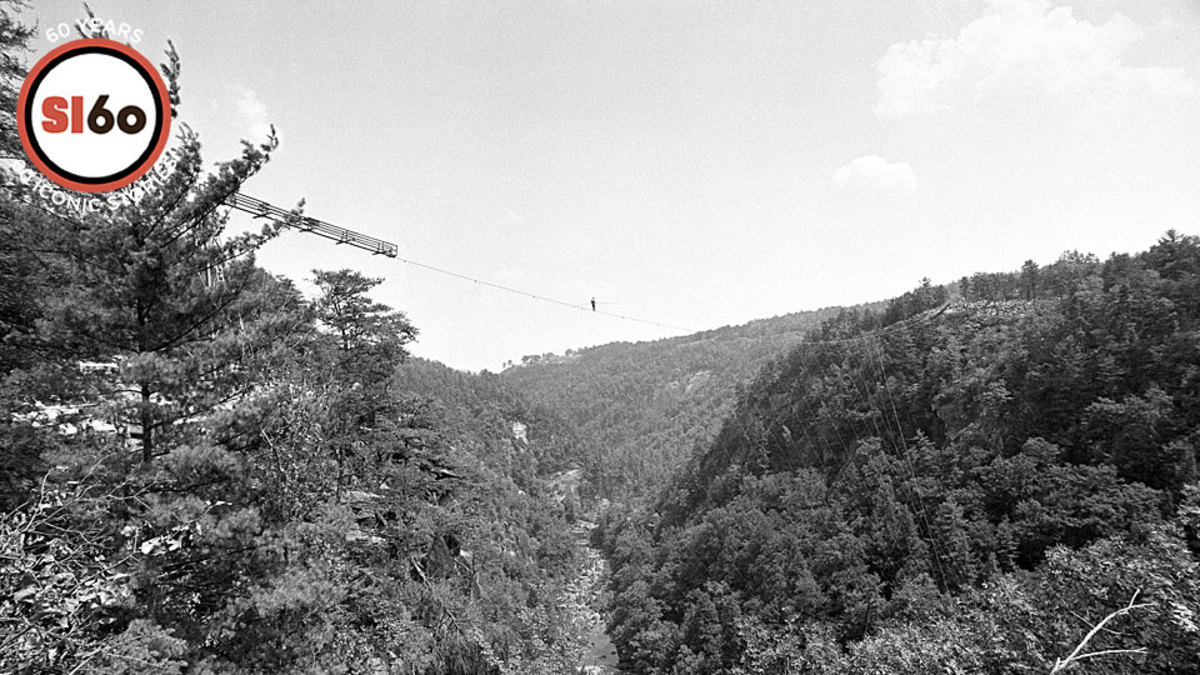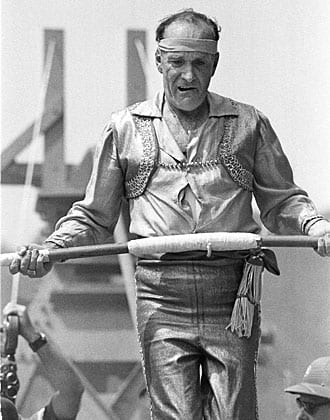The Smell Of Death Was In The Air: A daredevil faces his demons
Old Karl Wallenda walked a wire 750 feet above a rocky Georgia gorge, with every step a giant leap for this kind of man.
In honor of Sports Illustrated's 60th anniversary, SI.com is republishing, in full, 60 of the best stories the magazine very ran. Today's selection is "The Smell Of Death Was In The Air," which was published in the July 27 1970 issue. Mark Kram wrote an artful story of Karl Wallenda, who at age 65 was still cheating death by walking across wires stretched hundreds of feet above the ground and who had also had to deal with the worst imaginable tragedy -- twice.
Night moused across the northern hills of Georgia, then quickly fell, and all that could be seen was the swirling dust in front of the headlights and a faraway flicker across an open field. The glimmer was the weak light of a tent meeting, a revival which, like the storied moonshine of the South, is believed to be in decline and quite inferior. It may be, but it hardly seemed so here in this tent, filled with frantic moths and wet, comatose faces nodding at a frail, agitated preacher whose hands whipped at unseen evil "out there on this Georgia night."
"God is swift!" cried the preacher. "Oh, yeahhh," the crowd agreed. "He is swift," he said again. "Oh, yeahhh. He is. He's got an extrawwwordinary sense, that's what He has. That man, who's gonna go walkin' tomorrow, that man...he knows how swift the Lord is. Pray, brothers and sisters, pray for that man that the Lord won't be so swift tomorrow."
The man, the recipient of the reverend's spiritual largess, was Karl Wallenda, age 65, the most gifted high-wire artist in history. What Karl Wallenda was going to do seemed to cry for prayers, or perhaps a parachute. He was going to walk across Tallulah Gorge, close to a thousand feet wide and 750 feet in depth. It would be, aside from madness, the second greatest walk of all time: the moon, the promoters conceded reluctantly after lengthy debate, deserved top billing.
"When he falls off," a photographer asked an engineer, "what's the best way to get down to the bottom?"
"The same way he went," said the engineer.
SI 60: 'Lawdy, Lawdy, He's Great'
One could reach out and feel the quiver of bad vibrations in this speck of a town. Death, like a giant shadow, has always been near the lives of the Wallendas. First there was the accident in Detroit in 1962, which put two of them in graves and one in a wheelchair for life. Then, there was Yetta, who fell in Omaha and lay there with that worried look of the Wallendas lining her face even in death.
"My brother Karl is insane," said Herman Wallenda, looking out over the ominous gorge. "He does not need this...but the applause, ah, the applause.... It is his whole life...it is like a fine wine."
So, last Saturday afternoon, in front of 30,000 people and Governor Lester Maddox, who said that he, too, was praying real hard, Karl Wallenda took a walk in the 50th year of his career and made it look like a brisk evening constitutional. The sensitive life and wisdom in his size-seven feet carried him across the rock-studded gorge in 20 minutes and in 616 steps. For diversion he stood on his head twice. The striking aspect of it all, though, was not just spectacle. It was the portrait he presented, the towering physical strength and beautiful nerves under a pressure few ever feel.
This was, too, so human a thing, so movingly individualistic at a brutalizing period in history that finds men slipping deeper and deeper into the mold of mass man. The huge glistening machinery of our society seemed to come apart like a Tinker Toy with every step he took. He was alone, and it was truly staggering to imagine the amount of hard-rock assurance he must possess in his own power and invulnerability. The problems that confronted him were enormous: the thermal currents of the gorge, the 35-pound balancing pole that could suddenly seem like 200 pounds to an old man, and, finally, the deadly 821 feet of sloping downhill wire.
• SI 60: Read every story and interview in the collection
Yet he walked the wire (1 11/16 of an inch in diameter) 20 minutes faster than he thought he would. He was quite cautious early in the walk, and then he seemed to pick up the pace. As his tiny figure began to emerge slowly out of that awful, hot sky, one could see through field glasses a smile grow larger and larger on his rubbery, almost clownlike face. His wife, who has refused to watch him perform for eight years, hid her face in her hands. Only occasionally would she look up, and then she would begin to sob. When he reached the end he was promptly placed on a stretcher where he could be examined by doctors who were interested in his heartbeat. He remained under this observation only briefly, then walked over to the grandstand, trailed by 200 reporters and photographers, some from Europe, where he partook of a mammoth martini. "I've had two a day for 20 years," he says.
The crowd, there from all parts of the country and sensing tragedy, was visibly relieved that he survived. "You see, my friend," said brother Herman, "death has become good business for the Wallendas." Herman smiled ironically, and rightly so. The Wallendas have always been one of the great circus acts in the world, but even they never really made big money. The most they would make might be $2,500 a week, say, for one two-week stand, but there were seven of them in the act, their expenses were high and the playing dates quite uneven. Then came Detroit, and suddenly the name Wallenda took on a strange fascination. "I do not blame them, the people," says Herman. "It is what our lives have been all about. The smell of death, that is what we are about."
The memory of the accident trails Karl, the patriarch of the family, from day to day. He was and is the spirit of the family, a man admired and hated by many, yet always a man who commands genuine respect. He is a disciplined, mentally hard German with one of the great egos of the world, but not even his dedicated involvement with himself can chase the horror of Detroit. "I couldn't look down," he says. "There is a picture in my mind of the ring down there...and the boys. They are broken and still, and around them there are the balance poles and bars and the chair...just pieces. That picture is in my mind and I never lose it. If I look down once I know I will see it again...those boys. If I look I go mad. I don't look.
"We are about halfway through when I feel something is wrong," continues Karl. "Then I see that Dieter is not steady and I listen close. I hear that he is talking to himself. I know there is trouble. He is so close to the platform. Then I see there is something wrong with his pole. And then there is that voice, that cry—'Ich kann nicht mehr halten [I can't hold it any longer].' Then I see it drop. I know we are all going to go. I know this but I cannot believe it. Jana is at the top on the chair and she has no chance at all. I hit the wire hard and it feels as if it goes right through my crotch. Then Jana comes down on my back and she grabs me, and I hold on to her until I can drop her to safety. I went back up again two days later. You see, it has to be that way. If I go up I can concentrate on my work. Down here I see two people dead and one more almost dead."
Wallenda talked freely of death last week in the hills of Georgia, and it even startled the stone-hard hillsmen who admire iron in men. But, as one of them said, "Hit's the damned scariest thing I ever did see." The people and the region were a perfect backdrop for this event, which cost the promoters more than $60,000. The creation and construction of the wire alone cost $50,000, and Wallenda received $10,000. The admission was $5 per person. The money would go toward building an amphitheater where regional historical drama can be offered. The publicity, hopefully, would resurrect Tallulah as a summer resort. Whether any of this is ever realized, it still will always be remembered as an afternoon of strange charm.
Vaguely, it had the clamor of the Scopes trial in Dayton, Tenn., but a quality all its own and tableaus that stick in the mind: the old, old hill people looking emptily for hours out over the gorge and at the wire; the fine-looking women from downstate with their Zelda Fitzgerald faces or the plain Scotch-Irish faces, wearing big floppy hats and looking so deceptively fragile. And finally the hill talk: "the shine down here, hit ain't no more good anymore. Ya find anythink in it nowadays from Red Devil lye to parts of snakes and possums who get in the stuff at night." Or "Guvnor Maddox, you say. Why, we got the only real honest guvnor in this country. He don't steal a nickel. Why, Ole Lestah, he don't have sense enough ta steal nothin'."
The event belonged in these hills, and it really belonged to a time that is no more. But most of all it had the character—even though it was just a fragment—of the old circus that made a dream a reality suddenly one morning in an empty corner of a vacant lot. In Tallulah there was once again the smell of poster paste, the mysterious dancers from the Middle East who (curiously) chewed gum and looked at their nails and, if you could sneak on the lot after dark, there was that ghostly, scary sight of canvas in the moonlight. That was the way it felt in Tallulah Gorge, Ga., and only a technocrat would call it all frivolous and useless.
"Useless?" asks Karl Wallenda. "Why, it cannot ever be useless. To perform is to live, and everything else is waiting."






